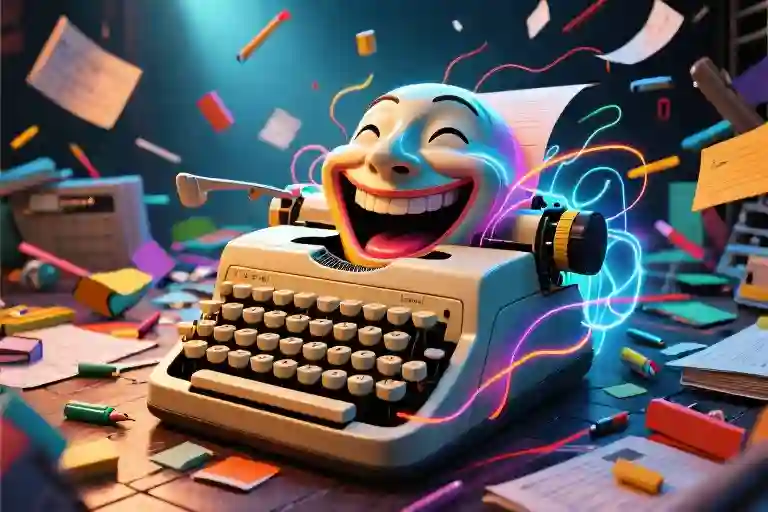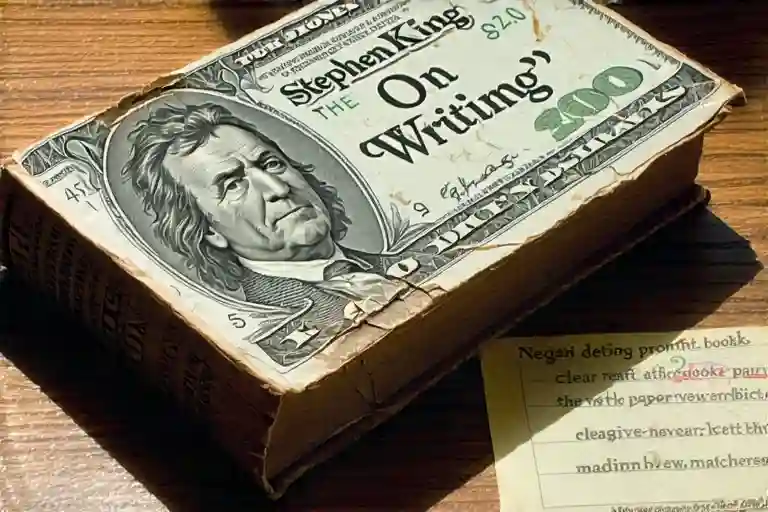The other day I watched a viral video where a guy received a notification that his stolen takeout had been delivered—with a five-star rating from the thief. At that moment, I realized my carefully crafted comedy sketches stood no chance against reality’s improv troupe. Life isn’t just writing better jokes than us; it’s performing them with straight-faced audacity while we scramble for notebooks.
This presents humor writers with our version of the robot uprising: how do you satirize situations that already feel like parody? When your roommate’s dating profile lists ‘breathing oxygen’ as a hobby, or corporate emails declare ‘quiet quitting’ an act of rebellion, the universe seems determined to out-absurd any punchline. The traditional comedy rulebook—exaggerate by 20%—fails when reality operates at 300% lunacy by default.
Yet this overload of material creates unexpected opportunities. The same outrageousness that makes us groan provides pre-loaded comedic tension—we just need the right tools to repackage it. That’s where techniques like Mapping transform life’s nonsensical beats into structured humor. Think of it as alchemy for the digital age: turning the lead of existential dread into comedy gold.
Consider how stand-up legends operate. When Gary Gulman dissects student loan bureaucracy, he doesn’t invent scenarios—he maps the existing insanity onto relatable frameworks (comparing financial aid forms to medieval torture devices). The humor emerges from recognition, not invention. Our advantage as writers lies in life having already done the heavy lifting of being unbelievable; we simply highlight the seams.
This approach solves two core problems for comedy writers: first, the paralysis of ‘nothing’s funny anymore’ (it is—just differently). Second, the ethical tightrope of joking about sensitive topics (by focusing on universal human reactions rather than events themselves). Mapping lets us process collective WTF moments through shared laughter rather than despair.
Your comedy toolbox starts with this foundational skill because it mirrors how our brains naturally cope. When we say ‘this meeting is like herding cats,’ we’re instinctively using Mapping to preserve sanity. The professional twist involves pushing the analogy further until it snaps into comedy—’herding cats…on Ambien…during a laser pointer convention.’ Suddenly, your soul-crushing Zoom call becomes crowd work.
In the sections ahead, we’ll break down Mapping into actionable steps while examining why our brains reward this particular flavor of humor. You’ll learn to identify the sweet spot where real-life situations become comedy-ready (hint: it’s usually when you find yourself muttering ‘you can’t make this shit up’). Because in today’s world, the most valuable creative skill isn’t imagination—it’s knowing what to do with the absurdity we’ve been handed.
Why Absurd Reality Makes the Best Comedy Material
There’s an unspoken rule in comedy writing: reality will always outdo your imagination. Just when you think you’ve crafted the most ridiculous scenario possible, life hands you a situation so bizarre it makes your jokes look tame. Remember the great toilet paper rush of 2020? No zombie apocalypse movie could have predicted that level of collective panic over two-ply.
This inherent absurdity in real life events gives humor writers an incredible advantage. Authentic situations carry built-in emotional resonance that fabricated scenarios often struggle to achieve. When we joke about universal experiences – like disastrous first dates or workplace frustrations – we’re tapping into shared human experiences that immediately click with audiences.
Consider why memes about mundane frustrations go viral faster than polished comedy sketches. That viral tweet about someone’s roommate eating their labeled food hits harder than any sitcom plot because it’s painfully real. The key lies in recognizing these golden nuggets of absurdity hidden in everyday life.
Three fundamental qualities make real-life events superior comedy material:
- Instant Recognition: When you describe the particular agony of listening to a coworker explain their dream in excruciating detail, half your audience will nod along before you even reach the punchline.
- Built-in Irony: Reality often serves irony on a silver platter. Like when you finally splurge on nice clothes and immediately spill coffee down your front – the universe practically writes the joke for you.
- Permission to Exaggerate: Because the core situation is true, you can take creative liberties with the details. That frustrating group project becomes funnier when you recast your teammates as characters from Lord of the Flies.
The toilet paper crisis exemplifies this perfectly. While zombie movies show people fighting over canned goods, reality gave us actual adults wrestling over Charmin. The humor writes itself because we’ve all witnessed some version of this irrational behavior. This shared recognition creates immediate connection – your audience isn’t just laughing at your joke, they’re laughing at their own memories of the situation.
This isn’t to say fictional humor lacks value. But when life serves up material this rich, ignoring it would be like a chef rejecting truffles to make boxed mac and cheese. The tools we’ll explore next simply help refine these raw ingredients into something even more potent.
What makes these real-life moments particularly valuable is their duality – they’re simultaneously specific enough to feel fresh, yet universal enough to resonate widely. Your story about your aunt’s conspiracy theories about the grocery store deli counter might seem hyper-specific, until you realize everyone has that one relative who’s convinced the system is rigged against them getting the good potato salad.
This intersection between the particular and the universal is where the best comedy lives. The more precisely you can describe your own experience of life’s absurdities, the more powerfully others will recognize their own version of that truth. That’s the alchemy we’re aiming for – transforming personal frustration into collective catharsis, one laugh at a time.
Mapping: The Comedian’s Secret Weapon
The best comedy often comes from taking something painfully familiar and twisting it just enough to make it ridiculous. That’s where mapping comes in – this technique lets you take the structure of one situation and superimpose it onto another, creating instant comedic friction.
Step 1: Mine Your Life for Conflict
Start with real events that made you want to scream into a pillow. Friendship breakups work beautifully – they have all the drama of romantic splits but none of the cultural scripts. That time your friend ghosted you after borrowing your favorite sweater? Perfect raw material.
Step 2: Find Your Analogous World
Now imagine that same scenario playing out in a completely different context. Legal proceedings offer rich territory:
“We regret to inform you that your friendship contract has been terminated due to multiple violations of the BFF code, specifically Article 4 (always sharing fries) and Article 7 (remembering birthdays). You may appeal this decision within 30 days.”
The more incongruous the pairing, the bigger the laugh. Corporate jargon applied to parenting? Medical terminology for dating? All fair game.
Step 3: Dial Up the Absurdity
Take your analogy and crank it to eleven. That 1-800-FRIENDS-4-NEVER idea? Now give it full infomercial treatment:
“Operators are standing by! Call now and receive our exclusive breakup package – includes one framed photo of happier times (frame not included), a playlist of ‘songs that remind me of better people,’ and this commemorative ‘I Survived the Friendship Purge’ t-shirt!”
Step 4: Test Your Material
The final check: does this make at least 60% of your friends do that snort-laugh thing? Try it out on:
- Your most brutally honest friend
- Someone who lived through the event with you
- A stranger at the bar (the ultimate focus group)
Pro Tip: Workplace meetings are mapping goldmines. Next time your boss says “let’s circle back,” imagine it’s actually happening aboard the Starship Enterprise:
“Captain’s log, stardate 2024. The away team remains trapped in the Conference Room Nebula, endlessly discussing Q2 projections. Morale deteriorates as the replicators produce only lukewarm coffee and stale donuts.”
The magic happens when the audience recognizes both the original situation and your twisted version simultaneously. It’s not just comedy – it’s collaborative revelation, a shared “oh god it really IS like that” moment that turns frustration into collective catharsis.
Beyond Mapping: Your Comedy Toolbox Starter Kit
Mapping might be your Swiss Army knife for turning life’s absurdities into comedy gold, but let’s rummage through the rest of your comedic toolbox. These are the implements you’ll reach for when reality serves up situations too bizarre for straightforward analogies.
Absurdity Amplification: When Small Problems Deserve Oscar-Worthy Dramas
That moment when your coffee order gets messed up for the third time this week? In normal life, it’s a mild annoyance. Through the lens of absurdity amplification, it becomes:
“The barista handed me my latte with that familiar look of quiet sabotage. I knew before tasting – caramel instead of vanilla, the third betrayal this week. My hands shook as I texted my support group: ‘Relapse. They got me again.’ The recovery meeting would be at dawn.”
This tool works by taking an everyday inconvenience and escalating it to apocalyptic proportions. Key ingredients:
- Treat minor inconveniences like life-or-death scenarios
- Borrow dramatic language from other genres (medical dramas, war films, etc.)
- Maintain absolute seriousness about the trivial
Try applying this to:
- Lost socks becoming an unsolved mystery case
- Printer jams as attempted office mutiny
- Group text replies as UN diplomatic crisis
Deadpan Delivery: The Straight Face Wins the Race
Sometimes the funniest approach is to state ridiculous things with the solemnity of a courtroom testimony. This is the domain of deadpan humor – where your facial expression stays neutral while describing utter nonsense.
Example application:
“According to new research from the Institute of Very Serious Science, people who rearrange supermarket displays to reach expiration dates further in the future demonstrate superior survival instincts. The study recommends job candidates list ‘proactive expiration date management’ as a core competency.”
Deadpan works because:
- The contrast between content and delivery creates cognitive dissonance
- It mimics the tone of authoritative sources (news anchors, academics)
- Allows audiences to “discover” the joke rather than having it announced
Practice by:
- Delivering ridiculous opinions in corporate buzzword language
- Explaining meme culture as anthropological phenomenon
- Narrating your pet’s activities like a nature documentary
Why These Tools Work (And When They Don’t)
At their core, these techniques all rely on the same psychological principle: perspective shifting. A 2021 University of Southern California study on humor cognition found that jokes triggering mental “frame switches” activate greater dopamine release than straightforward punchlines.
But beware the pitfalls:
- Absurdity amplification loses potency if overused (save it for truly mundane situations)
- Deadpan requires careful audience calibration (not everyone reads subtle delivery)
- Both techniques demand precise timing – the beat before the laugh matters
Your Comedy Homework
Before we dive deeper into specific tools next time (get ready for “How to Turn Your Boss’s Emails Into Haiku”), try this:
Take yesterday’s most irritating moment and run it through both tools:
- First as an overblown catastrophe
- Then as a dryly reported news item
The best comedy often lives in the tension between these approaches – much like life itself, which keeps giving us front-row seats to shows we never bought tickets for.
Why Humor Disarms Pain
There’s something almost alchemical about how a well-timed joke can transform a painful experience into something bearable. It’s not magic, though – it’s neuroscience and psychology working in tandem. When we apply humor writing techniques to life’s absurdities, we’re essentially performing cognitive reframing with punchlines.
Cognitive reframing, a concept from positive psychology, suggests that humor allows us to change the mental frameworks through which we view stressful events. That disastrous Tinder date isn’t just painful – it’s potential material for your next comedy bit. The psychology behind this explains why comedy writing workshops often feel like group therapy sessions, where participants laugh hardest at the stories that probably hurt the most when they happened.
Professional comedians have known this secret for generations. Take Tig Notaro’s legendary 2012 stand-up set at Largo, performed just days after her cancer diagnosis. By addressing the trauma directly through deadpan delivery and absurd analogies (“I have cancer, how was your week?”), she demonstrated humor’s power to create emotional distance from pain. The audience’s laughter wasn’t at her suffering, but at the shared recognition of life’s unpredictable cruelty – what psychologists call “benign violation theory.”
This explains why the mapping technique works so effectively in humor writing. When we compare a friendship breakup to dramatic courtroom proceedings, we’re not minimizing the real hurt. We’re giving our brains alternative neural pathways to process the experience – pathways that bypass the usual pain centers and activate the reward system instead. fMRI studies show that successful jokes light up both the prefrontal cortex (for pattern recognition) and the limbic system (for emotional release), creating what researchers call a “cognitive-emotional cocktail” that helps us cope.
What’s fascinating is how this process differs from simple distraction. Quality humor writing doesn’t avoid the pain – it stares directly at it while wearing a clown nose. That’s why the best comedy often comes from marginalized voices who’ve endured real hardship. Their jokes become psychological tools for reclaiming power, transforming “things done to them” into “material created by them.”
For aspiring humor writers, this means your most painful experiences might be your most valuable creative assets. The key is developing what psychologists term “humor competence” – the ability to find that precise angle where darkness meets levity without trivializing either. It’s why comedy writing workshops often begin with participants sharing their worst days, then brainstorming how to map those experiences onto ridiculous analogies. The therapeutic effect comes not from avoiding reality, but from weaponizing it with laughter.
This psychological mechanism also explains why some attempts at humorous writing fall flat. Jokes that are too distant from the pain feel hollow; those too close to it feel cruel. The sweet spot – what researchers call the “humor zone” – exists where the writer has processed enough to gain perspective but still connects emotionally to the material. It’s why the most resonant comedy writing often emerges months or years after traumatic events, once the initial sting has faded but the emotional truth remains.
Understanding this psychology can make you a better humor writer. When crafting your next piece, ask yourself: Does this joke help reframe the pain, or just mock it? Does the laughter come from recognition or discomfort? The answers will determine whether your humor writing merely entertains or actually transforms – both for your audience and yourself.
Wrapping It Up With a Punchline
The real magic of humor writing happens when you stop staring blankly at life’s absurdities and start weaponizing them. That pile of dirty laundry mocking you from the corner? It’s not just procrastination fuel – it’s a potential comedy bit about textile rebellion waiting to be mapped onto a Game of Thrones-style epic. Your disastrous Tinder date last weekend? That’s not cringe-worthy, that’s premium raw material for a romantic comedy parody.
Your Turn to Map the Madness
Here’s your backstage pass to the comedy writers’ room: Take one genuinely frustrating moment from your week (we all have them) and run it through the Mapping machine:
- Identify the annoyance (e.g., your neighbor’s dog won’t stop barking at 3 AM)
- Find the dramatic parallel (UN peacekeeping mission? Zoo escape incident? Alien first contact protocol?)
- Push it to ridiculous extremes (Perhaps draft a formal diplomatic communiqué to the canine ambassador)
The best submissions will get featured in our next installment – bonus points if you can make us snort coffee through our noses.
Coming Attractions: Turning Up the Absurd
Next time, we’re cranking the dial to eleven with Absurdity Amplification – because sometimes reality isn’t quite ridiculous enough. Learn how to transform:
- Workplace meetings → Dystopian survival trials
- Family group texts → Shakespearean tragedies
- Gym self-consciousness → Olympic-level performance anxiety
We’ll provide the comedic hyperbole, you bring the everyday irritations that deserve theatrical treatment.
Parting Thought
Remember what the ancient philosophers never actually said: ‘Life doesn’t have to be funny to be meaningful, but it sure helps when you’re stuck in traffic behind someone doing 15 under the limit.’ Your ability to laugh at the madness isn’t just survival – it’s creative rebellion. Now go forth and misbehave (with words).





